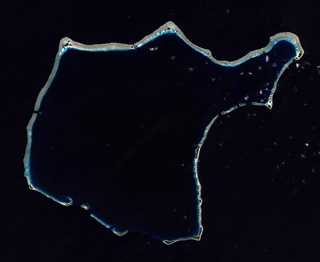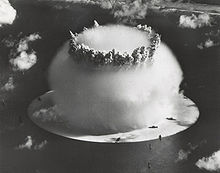
Bikini Atoll, known as Eschscholtz Atoll between the 19th century and 1946, is a coral reef in the Marshall Islands consisting of 23 islands surrounding a 229.4-square-mile (594.1 km2) central lagoon. The Atoll is at the northern end of the Ralik Chain, approximately 530 miles (850 km) northwest of the capital Majuro.

Enewetak Atoll is a large coral atoll of 40 islands in the Pacific Ocean and with its 296 people forms a legislative district of the Ralik Chain of the Marshall Islands. With a land area total less than 5.85 square kilometers (2.26 sq mi), it is no higher than 5 meters (16.4 ft) and surrounds a deep central lagoon, 80 kilometers (50 mi) in circumference. It is the second-westernmost atoll of the Ralik Chain and is 305 kilometers (190 mi) west from Bikini Atoll.

Operation Crossroads was a pair of nuclear weapon tests conducted by the United States at Bikini Atoll in mid-1946. They were the first nuclear weapon tests since Trinity on July 16, 1945, and the first detonations of nuclear devices since the atomic bombing of Nagasaki on August 9, 1945. The purpose of the tests was to investigate the effect of nuclear weapons on warships.

Nuclear weapons tests are experiments carried out to determine the performance, yield, and effects of nuclear weapons. Testing nuclear weapons offers practical information about how the weapons function, how detonations are affected by different conditions, and how personnel, structures, and equipment are affected when subjected to nuclear explosions. However, nuclear testing has often been used as an indicator of scientific and military strength. Many tests have been overtly political in their intention; most nuclear weapons states publicly declared their nuclear status through a nuclear test.

Operation Castle was a United States series of high-yield (high-energy) nuclear tests by Joint Task Force 7 (JTF-7) at Bikini Atoll beginning in March 1954. It followed Operation Upshot–Knothole and preceded Operation Teapot.

Ebeye is the most populous island of Kwajalein Atoll in the Marshall Islands, as well as the center for Marshallese culture in the Ralik Chain of the archipelago. Settled on 80 acres of land, it has a population of more than 15,000. Over 50% of the population is estimated to be under the age of 18.

Operation Sandstone was a series of nuclear weapon tests in 1948. It was the third series of American tests, following Trinity in 1945 and Crossroads in 1946, and preceding Ranger. Like the Crossroads tests, the Sandstone tests were carried out at the Pacific Proving Grounds, although at Enewetak Atoll rather than Bikini Atoll. They differed from Crossroads in that they were conducted by the Atomic Energy Commission, with the armed forces having only a supporting role. The purpose of the Sandstone tests was also different: they were primarily tests of new bomb designs rather than of the effects of nuclear weapons. Three tests were carried out in April and May 1948 by Joint Task Force 7, with a work force of 10,366 personnel, of whom 9,890 were military.

Rongelap AtollRONG-gə-lap is an uninhabited coral atoll of 61 islands in the Pacific Ocean, and forms a legislative district of the Ralik Chain of the Marshall Islands. Its total land area is 8 square miles (21 km2). It encloses a lagoon with an area of 1,000 square miles (2,600 km2). It is historically notable for its close proximity to US hydrogen bomb tests in 1954, and was particularly devastated by fallout from the Castle Bravo test. The population asked the US to move them from Rongelap following the test due to high radiation levels with no success so they asked global environmental group Greenpeace to help. The Rainbow Warrior made four trips moving the islanders, their possessions and their homes to the island of Mejato in the Kwajalein Atoll, 180 kilometers away.

Castle Bravo was the first in a series of high-yield thermonuclear weapon design tests conducted by the United States at Bikini Atoll, Marshall Islands, as part of Operation Castle. Detonated on March 1, 1954, the device remains the most powerful nuclear device ever detonated by the United States and the first lithium deuteride-fueled thermonuclear weapon tested using the Teller-Ulam design. Castle Bravo's yield was 15 megatons of TNT [Mt] (63 PJ), 2.5 times the predicted 6 Mt (25 PJ), due to unforeseen additional reactions involving lithium-7, which led to radioactive contamination in the surrounding area.

Ivy Mike was the codename given to the first full-scale test of a thermonuclear device, in which part of the explosive yield comes from nuclear fusion. Ivy Mike was detonated on November 1, 1952, by the United States on the island of Elugelab in Enewetak Atoll, in the now independent island nation of the Marshall Islands, as part of Operation Ivy. It was the first full test of the Teller–Ulam design, a staged fusion device.

Rongerik Atoll or Rongdrik Atoll is an unpopulated coral atoll of 17 islands in the Pacific Ocean, and is located in the Ralik Chain of the Marshall Islands, approximately 200 kilometers (120 mi) east of Bikini Atoll. Its total land area is only 1.68 square kilometers (0.65 sq mi), but it encloses a lagoon of 144 square kilometers (56 sq mi).

Operation Hardtack I was a series of 35 nuclear tests conducted by the United States from April 28 to August 18 in 1958 at the Pacific Proving Grounds. At the time of testing, the Operation Hardtack I test series included more nuclear detonations than the total of prior nuclear explosions in the Pacific Ocean. These tests followed the Project 58/58A series, which occurred from 1957 December 6 to 1958, March 14, and preceded the Operation Argus series, which took place in 1958 from August 27 to September 6.

Ailinginae Atoll is an uninhabited coral atoll of 25 islands in the Pacific Ocean, on the northern end of the Ralik Chain of the Marshall Islands. Its total land area is only 2.8 square kilometers (1.1 sq mi), but it encloses a lagoon of 105.96 square kilometers (40.91 sq mi). It is located approximately 13 kilometers (8.1 mi) west of Rongelap Atoll. The landscape is low-lying with only the top 3 meters (9.8 ft) above sea level. The two entrances into the lagoon are 'Mogiri Pass' and 'Eniibukku Pass'. These are 1.45 and 0.48 kilometers wide respectively.

Project 4.1 was the designation for a medical study and experimentation conducted by the United States of those residents of the Marshall Islands exposed to radioactive fallout from the March 1, 1954 Castle Bravo nuclear test at Bikini Atoll, which had an unexpectedly large yield. Government and mainstream historical sources point to the study being organized on March 6 or March 7, 1954, less than a week after the Bravo shot.

Jeton Anjain was a Minister of Health and a senator of the Marshall Islands Parliament. He received the Goldman Environmental Prize in 1992, for his efforts to help people from the Rongelap Atoll, which was subject to nuclear contamination after the test of the Castle Bravo hydrogen bomb in 1954. In 1991, he and the Rongelap People were awarded the Right Livelihood Award for "their steadfast struggle against United States nuclear policy in support of their right to live on an unpolluted Rongelap island."
Lijon Eknilang was a Marshallese activist and nuclear fallout survivor. Eknilang advocated on behalf of residents of Rongelap Atoll, who were victims of nuclear fallout stemming from the Castle Bravo hydrogen bomb test at Bikini Atoll in 1954.

Nuclear testing at Bikini Atoll consisted of the detonation of 24 nuclear weapons by the United States between 1946 and 1958 on Bikini Atoll in the Marshall Islands. Tests occurred at 7 test sites on the reef itself, on the sea, in the air, and underwater. The test weapons produced a combined yield of about 75 Mt of TNT in explosive power.
Darlene Keju, also known as Darlene Keju-Johnson, was a Marshallese activist. She was born on Ebeye Island in the Marshall Islands group in 1951. The Northern Islands where she grew up were downwind from Bikini and Enewetak atolls where the United States tested 67 nuclear weapons. She witnessed the evacuation of Regelap and Utirik Atolls after they were contaminated by radioactive fallout. Keju is credited for bringing to the attention of the world the suffering of the Marshall Islanders as a result of the nuclear testing and that many more people were affected than acknowledged by the U.S. government.
Marshall Islands Nuclear Claims Tribunal is an international arbitral tribunal established pursuant to the Agreement Between the Government of the United States and the Government of the Marshall Islands for the Implementation of Section 177 of the Compact of Free Association. The Claims Tribunal has the "jurisdiction to render final determination upon all claims past, present and future, of the Government, citizens and nationals of the Marshall Islands which are based on, arise out of, or are in any way related to the [American] Nuclear Testing Program."

Naval Base Marshall Islands were United States Navy advance bases built on the Marshall Islands during World War II to support the Pacific War efforts. The bases were built by US Navy after the Marshall Islands campaign that captured the islands from the Empire of Japan. By February 1944 the United States Armed Forces had captured the islands. Most of the airfields and other facilities Japan had built were destroyed in allied bombing raids and naval bombardment. US Navy Seabee Construction Battalions arrived as soon as the area was secured and remove the debris. The Seabees quickly repaired, built and improved the airfield/runways and seaport. Seabees often worked around the clock to get airfields operational so that fighter aircraft and bombers could start operating. The bases were used for staging upcoming campaigns and for repair.



















